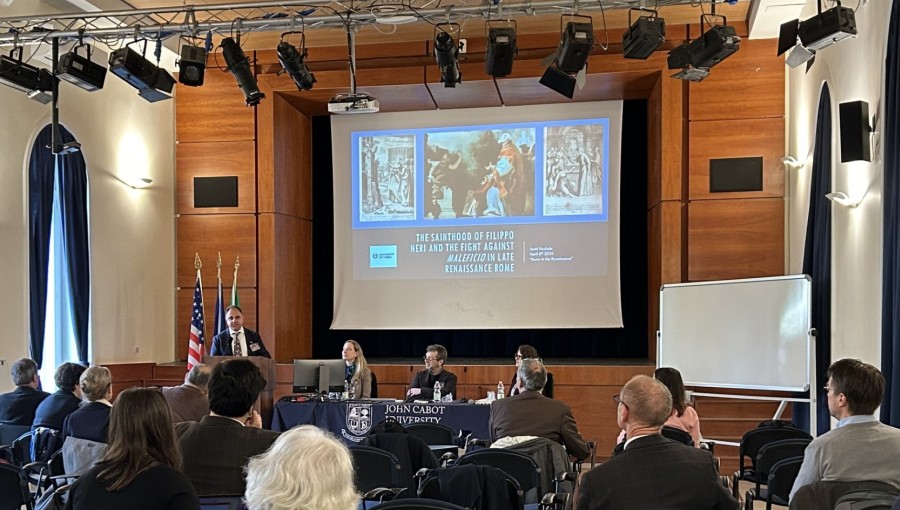The Americanization of the World in the 20th Century: A Lecture by Daniele Fiorentino
The Guarini Institute for Public Affairs welcomed Professor Daniele Fiorentino (Università di Roma 3) for the lecture “The Americanization of the World in the Early 20th Century” on February 25, 2019.

Daniele Fiorentino
The talk focused on the strategic policy of soft power that favored American expansion as a global power in the 20th Century. Soft power is the ability to shape the preferences of others by appealing and attracting, rather than coercing (hard power). Professor Fiorentino delivered a comparative analysis of American political soft power and its influence in Europe, which, on the other hand, significantly depended on hard power.
Professor Fiorentino began by explaining the idea of “Americanization” and the meaning of the expression “An American way of life.” The expression was based on the triumph of American soft power and the possibility of building “an empire for liberty.” Prof. Fiorentino claimed that Theodore Roosevelt’s racial and civic nationalism ideals were paramount to the expression’s meaning. Although both hard and soft power have long been used in European politics, the soft power concept, postulated by political scientist Joseph Nye, benefited the USA in the 20th century more than hard power.
According to Prof. Fiorentino, Americanization was born at the end of the 19th century. The so-called “Progressive Era” was a time in which Americans had to face immigration and promoted assimilation to their culture. Policies to transform immigrants into true Americans produced a new American identity, forged on the model of an Anglo-Saxon white male. In other words, “the process of the melting pot” contributed to creating the foundations of “a new republican empire” whose power would later spread around the world.
In the first half of the 20th century, the US adopted two strategies, integration and assimilation, and foreign assistance. These strategies influenced expansion policies both within the US and abroad. Domestically, the US welcomed ethnic or “racial” minorities to participate in the new society. Theodore Roosevelt even invited Booker T. Washington to the White House. This marked the first time in US history where a black person could meet on an equal footing with no other than the President of the US. As part of his foreign policy, Roosevelt built a naval fleet (1907/1908) to show the might of the new American power, and when needed, would provide assistance to countries across the world. After the 1908 earthquake in Messina, Italy, the US fleet provided health assistance to many people in Sicily and Calabria.
While domestic policies focused on integration and assimilation into American culture, foreign policies focused on expansion. In short, they were soft power strategies that promoted liberal ideals within the US and across its borders. According to Prof. Fiorentino, Roosevelt believed that anyone who benefited from US foreign policy would also embrace its values, and eventually become a resource for them.
This belief was executed through media and technology. Although Europe also used artistic products as a medium to convey its values and beliefs, America started providing affordable cinema. This facilitated communication between the US and other countries. Rhetoric such as “together we win” strengthened nationalism through the inclusion of minorities in the media. In addition, around 1917, the Committee of Public Information (CPI) promoted the use of foreign languages on product labels and advertisements within and outside the US. Notably, Hollywood later created a movie industry, and its success was unprecedented in history.
Since the 1910s, automation of machinery was introduced to make life easier. Introduction of modern appliances such as washers, photo cameras, sewing machines, and typewriters made life easier not only for Americans but also for many people abroad, indirectly contributing to reinforcing American values.
Although the Cold War divided the world into two poles, it strengthened American identity and its power internationally. As part of the expansion project, the US gave higher consideration to countries in the Pacific area, such as Japan, the Philippines, and Guam, rather than Europe. These were identified as an easier target for the assimilation of American values. Moreover, diversity in the Pacific area inspired the US to reformulate the liberal concept of the West. Meanwhile, the US continued to represent Europe’s major focus. Europe considered the US expansion as a form of American imperialism, which proved to be true seeing how it increased its political and economic superiority over other countries. Around the 1900s countries such as Cuba, Venezuela, Panama and, Mexico experienced US interference in their politics.
In conclusion, Prof. Fiorentino claimed that the US first contributed to the making of a modern mass society while creating the infrastructure of its soft power. Later, this would become a major weapon of the US as a world power. Moreover, in World War I the government used the CPI as a propaganda tool to garner civil support in preparing the people for a new more integrated, and efficient society. This promoted a social structure based on information and propaganda that focused on the Americanization of society within and the success of the American way of life outside the country’s borders. As it Americanized its own society, the US projected the process overseas. This was only the beginning of what came to be known as the American century.
(Daniel Brobbey)





